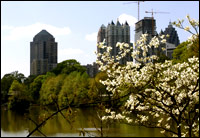Atlanta, Ga.: the famous “Hot-lanta” of Southern heat and hospitality, home of “down-home” fried chicken and a growing black middle class, cradle of the largest historically black college community in the world, hotbed of the civil-rights movement, and … the sprawl capital of the South.

As Atlanta gets greener, who will benefit?
Photo: iStockphoto.
As a resident of Atlanta for the past 15 years, I have witnessed one bad urban-planning decision after another. I have watched the fare for public transportation go up to pay for its expansion into the suburbs, while services in the inner city got cut — a double whammy for the poor and transit-dependent who make up the system’s core ridership. I have seen public housing for poor, black, and elderly residents be converted into upscale condos and townhouses. I have seen a boom in McMansions in historic inner-city neighborhoods, raising property values, contributing to global warming, and making it almost impossible for longtime residents to remain.
Now, I see a proposal that seems, at first glance, like it should be welcome. The city of Atlanta is embarking on one of the most massive redevelopment initiatives in its history: the BeltLine, an ambitious project to transform a mostly unused railroad into a 22-mile, in-town loop of parks, trails, and transit. The plan will increase overall parklands by over 1,200 acres (this, in a city that has significantly less green space than others of similar size around the country) while adding walking trails and bike paths and improving public transportation into the urban core.
On the surface, the BeltLine sounds like a great project, and it could be one. But, although the proposal promises an unprecedented amount of affordable housing units, questions like, “what is affordable?” and “affordable for whom?” have been sidelined in the public debate. Meanwhile, the project also includes plans to develop an abundance of upscale housing in Atlanta’s inner city, likewise raising many questions about the likely effect on poor and moderate-income neighborhoods. Thus far, the plan’s backers have failed to take these questions seriously — which speaks volumes about the larger failure of civic leaders to sufficiently incorporate the poor and working class into their process and vision.
Without a fight, I am concerned that these neighborhoods (mine included) will not receive their fair share of the project’s economic benefits. I am concerned that they will not be adequately connected to the BeltLine via the new transportation alternatives. I am concerned that they will not benefit equally from the improved parks system and environmental protection and remediation. And I am concerned that, if these neighborhoods do benefit, those who currently make their homes there will not be able to afford to stay.
These concerns are rooted in my awareness of patterns of community transformation across the country. Time and again, when long-neglected poor and polluted neighborhoods are revitalized, they cease to be affordable for the people who lived there (mostly from lack of choice) through the tough times.
Take Atlanta: The region’s rapid growth in the 1990s perpetuated suburban sprawl and economic disinvestment in Atlanta’s central city. Now, after years of long commutes and unbearable traffic congestion, those who abandoned the city want to come back and create a new Atlanta. City officials welcome this reverse migration and the increase in the tax base that it will undoubtedly bring. But poor and moderate-income citizens know to fear the likely outcome: property taxes, mortgages, and rents will skyrocket. Those who lived in poverty and pollution for years will essentially be shipped out when their neighborhoods are “cleaned up.” Poverty will not be eradicated; it will simply be exiled.
If the BeltLine project is going to buck this pattern and help meet the needs of the citizens who could benefit the most, many as-yet-unanswered questions will have to become central to the public debate. What is the timeline for the revitalization, and which areas will be prioritized? Will quality-of-life enhancements for underserved and blighted neighborhoods come late or never, while middle- and upper-income residents benefit sooner? Will the maintenance facilities required for the transit system and other industrial uses be equitably distributed, or will they continue to be concentrated in the lower-end real-estate markets?
As a community leader, I have been invited to numerous pep rallies for the project. But I have been to far too few meetings where the presenters go beyond the canned, pro-BeltLine presentations and answer real questions like these. Indeed, the fact that months after the primary financing for the project has been secured many people in blighted neighborhoods know little or nothing about it is indicative of the limited outreach conducted — despite boasts from the plan’s proponents that they have engaged residents in the process. Moreover, the same people who are touting inner-city transit as a BeltLine gain have been silent on the subject of much-needed capital and service improvements to the existing transit system — improvements that would better serve those who most rely on and financially support the system.
The “pros” of the BeltLine project can be hyped ad infinitum, but without real action to address key economic and social-justice issues, the project will fall prey to the same old unjust pattern of urban development. At the end of the day, Atlanta’s long-suffering inner-city residents need to know: Will the BeltLine equitably distribute economic growth, improved transit, and environmental amenities? Or will it follow the course of other Atlanta revitalization efforts — making way for the rich folks while moving the poor and underserved out of benefit’s way?



